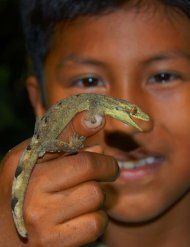Cuba: Camagüey, Sierra de Cubitas - The Field Museum
Cuba: Camagüey, Sierra de Cubitas - The Field Museum
Cuba: Camagüey, Sierra de Cubitas - The Field Museum
You also want an ePaper? Increase the reach of your titles
YUMPU automatically turns print PDFs into web optimized ePapers that Google loves.
egistered for the area previously but not observed<br />
during this inventory.<br />
<strong>Cuba</strong>n Parakeet (Aratinga euops; Fig. 5E) is<br />
a very rare species in the <strong>Sierra</strong> <strong>de</strong> <strong>Cubitas</strong>. It was not<br />
registered during this inventory, but A. Kirkconnell<br />
observed it there once and local gui<strong>de</strong>s claim to have<br />
seen groups of up to 12 individuals. Both Gundlach’s<br />
Hawk and <strong>Cuba</strong>n Parakeet are associated with forest,<br />
therefore maintaining ample forest cover will improve<br />
their chances for survival in the region.<br />
<strong>The</strong> <strong>Cuba</strong>n Parrot (Amazona leucocephala)<br />
is rare in the <strong>Sierra</strong> <strong>de</strong> <strong>Cubitas</strong>. It has been observed<br />
regularly in Paso <strong>de</strong> Lesca during the past two years<br />
(2004 and 2005). Prior to 2004, it was not seen often<br />
or consistently there. A. Kirkconnell observed it<br />
on only three occasions in 1999 and 2000. We did not<br />
observe it during our rapid inventory. This and the<br />
<strong>Cuba</strong>n Parakeet require further studies to ensure that<br />
their feeding and nesting sites receive protection.<br />
Other observations<br />
On several occasions we observed Crested Caracaras<br />
(Caracara cheriway) in the savannas near the base of<br />
the <strong>Sierra</strong> <strong>de</strong> <strong>Cubitas</strong>.<br />
THREATS AND RECOMMENDATIONS<br />
<strong>The</strong> threats influencing the survival of the area’s<br />
avifauna inclu<strong>de</strong> (1) the conversion of forests into<br />
agricultural land and easy access to the area via many<br />
trails (which makes it difficult to control <strong>de</strong>forestation);<br />
(2) the presence of <strong>de</strong>nsely populated and agricultural<br />
areas, like the Valle <strong>de</strong> Corea; (3) the invasion of<br />
Dichrostachys, an exotic species that replaces native<br />
plants; (4) feral animals, such as pigs (which <strong>de</strong>stroy<br />
the un<strong>de</strong>rstory and ground-dwelling organisms) and<br />
dogs; (5) livestock grazing in the savannas; and<br />
(6) poaching of doves.<br />
For bird conservation and management in<br />
the region, we recommend the following: (1) extend the<br />
protected area (or at least extend the management zone<br />
for native biodiversity) to inclu<strong>de</strong> the all of the forest<br />
96 RAPID BIOLOGICAL INVENTORIES INFORME/REPORT NO. 08<br />
in the <strong>Sierra</strong>; (2) increase the number of forest guards;<br />
(3) protect the palm-savannas, which are areas that still<br />
retain much native biodiversity; (4) eliminate or control<br />
feral animals (especially pigs and dogs) in the forest;<br />
(5) increase the area’s fencing to keep cattle and goats<br />
out; and (6) promote and protect nesting sites of<br />
<strong>Cuba</strong>n Parakeets and <strong>Cuba</strong>n Parrots to augment their<br />
populations in the region.<br />
MAMMALS<br />
Participant/Author: Stephen Díaz-Franco<br />
Conservation objects: <strong>Cuba</strong>n hutia (Capromys pilori<strong>de</strong>s) and<br />
prehensile-tailed hutia (Mysateles prehensilis) because they are<br />
hunted, and species of bats consi<strong>de</strong>red as near-threatened<br />
World Conservation Union<br />
INTRODUCTION<br />
Eighteen species of living mammals have been recor<strong>de</strong>d<br />
in the literature for the <strong>Sierra</strong> <strong>de</strong> <strong>Cubitas</strong> (Silva 1979;<br />
Camacho et al. 1995).<br />
METHODS<br />
To <strong>de</strong>tect the presence of mammals, I used a<br />
combination of direct observation and indirect evi<strong>de</strong>nce<br />
(such as i<strong>de</strong>ntifying scat found between the limestone<br />
crevices), following methods used by Garrido (1971).<br />
During the rapid inventory, I visited Paso <strong>de</strong> Lesca,<br />
Paso <strong>de</strong> La Vigueta, and other nearby areas.<br />
RESULTS<br />
During the inventory, I observed only <strong>Cuba</strong>n hutia<br />
(Capromys pilori<strong>de</strong>s), the most common of our hutias.<br />
Including living, extirpated, and extinct mammals, there<br />
are 3 or<strong>de</strong>rs, 11 families, 21 genera, and 25 species<br />
recor<strong>de</strong>d in the <strong>Sierra</strong> (Appendix 9).<br />
<strong>The</strong> 17 species of Chiroptera (bats) recor<strong>de</strong>d in<br />
the area represent 68% of <strong>Cuba</strong>’s bat species (Figs. 6A,<br />
6B). Of the <strong>Sierra</strong>’s bats, 16 are living species and<br />
Natalus major primus is known only from bone remains.

















